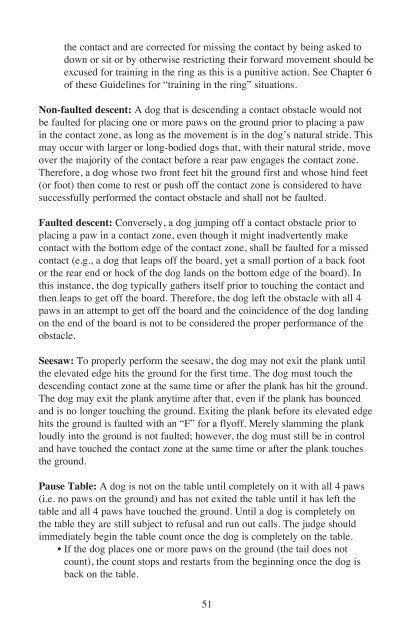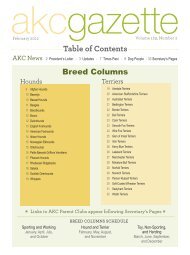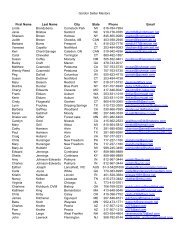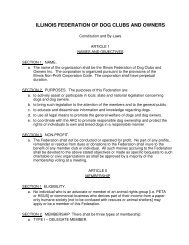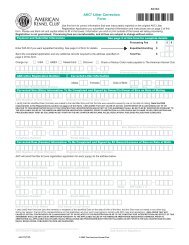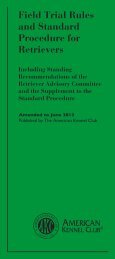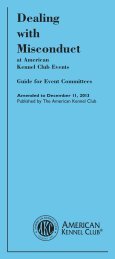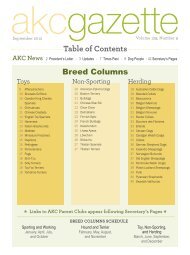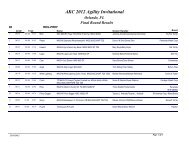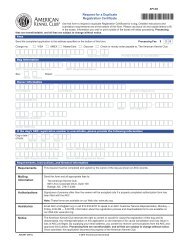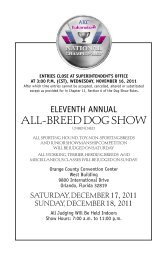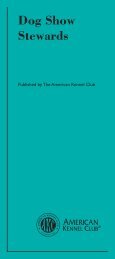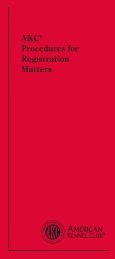You also want an ePaper? Increase the reach of your titles
YUMPU automatically turns print PDFs into web optimized ePapers that Google loves.
the contact and are corrected for missing the contact by being asked to<br />
down or sit or by otherwise restricting their forward movement should be<br />
excused for training in the ring as this is a punitive action. See Chapter 6<br />
of these <strong>Guidelines</strong> for “training in the ring” situations.<br />
Non-faulted descent: A dog that is descending a contact obstacle would not<br />
be faulted for placing one or more paws on the ground prior to placing a paw<br />
in the contact zone, as long as the movement is in the dog’s natural stride. This<br />
may occur with larger or long-bodied dogs that, with their natural stride, move<br />
over the majority of the contact before a rear paw engages the contact zone.<br />
Therefore, a dog whose two front feet hit the ground first and whose hind feet<br />
(or foot) then come to rest or push off the contact zone is considered to have<br />
successfully performed the contact obstacle and shall not be faulted.<br />
Faulted descent: Conversely, a dog jumping off a contact obstacle prior to<br />
placing a paw in a contact zone, even though it might inadvertently make<br />
contact with the bottom edge of the contact zone, shall be faulted for a missed<br />
contact (e.g., a dog that leaps off the board, yet a small portion of a back foot<br />
or the rear end or hock of the dog lands on the bottom edge of the board). In<br />
this instance, the dog typically gathers itself prior to touching the contact and<br />
then leaps to get off the board. Therefore, the dog left the obstacle with all 4<br />
paws in an attempt to get off the board and the coincidence of the dog landing<br />
on the end of the board is not to be considered the proper performance of the<br />
obstacle.<br />
Seesaw: To properly perform the seesaw, the dog may not exit the plank until<br />
the elevated edge hits the ground for the first time. The dog must touch the<br />
descending contact zone at the same time or after the plank has hit the ground.<br />
The dog may exit the plank anytime after that, even if the plank has bounced<br />
and is no longer touching the ground. Exiting the plank before its elevated edge<br />
hits the ground is faulted with an “F” for a flyoff. Merely slamming the plank<br />
loudly into the ground is not faulted; however, the dog must still be in control<br />
and have touched the contact zone at the same time or after the plank touches<br />
the ground.<br />
Pause Table: A dog is not on the table until completely on it with all 4 paws<br />
(i.e. no paws on the ground) and has not exited the table until it has left the<br />
table and all 4 paws have touched the ground. Until a dog is completely on<br />
the table they are still subject to refusal and run out calls. The judge should<br />
immediately begin the table count once the dog is completely on the table.<br />
• If the dog places one or more paws on the ground (the tail does not<br />
count), the count stops and restarts from the beginning once the dog is<br />
back on the table.<br />
51


